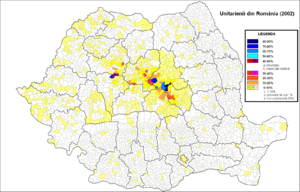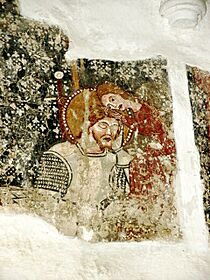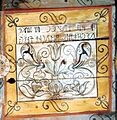Unitarian Church of Transylvania facts for kids
Quick facts for kids Unitarian Church of Transylvania |
|
|---|---|

Official insignia of the Unitarian Church of Transylvania
|
|
| Type | Nontrinitarian Christianity |
| Classification | Radical Protestant |
| Orientation | Unitarianism |
| Theology | Summa Universae Theologiae Christianae secundum Unitarios |
| Polity | Quasi-episcopal |
| Bishop | Rev. István Kovács |
| Associations | International Council of Unitarians and Universalists, European Liberal Protestant Network |
| Region | Romania, Hungary |
| Headquarters | Unitarian Church, Cluj-Napoca, Romania |
| Founder | Ferenc Dávid; |
| Origin | 1568 |
| Separated from | Hungarian Reformed Church |
| Members | 60,000 in Romania 25,000 in Hungary |
| Secondary schools | 2 |
| Tertiary schools | Protestant Theological Institute of Cluj |
| Other name(s) | Hungarian Unitarian Church |
| Official website | www.unitarius.org |
The Unitarian Church of Transylvania is a Christian group based in Cluj-Napoca, Transylvania, Romania. It is also known as the Hungarian Unitarian Church. This church is part of the Unitarian tradition. This means they believe in one God, but not in the idea of the Trinity (God as Father, Son, and Holy Spirit).
The church was started in 1568 by a preacher named Ferenc Dávid. This makes it the oldest Unitarian church that is still active today. Most of its followers are from the Hungarian community in Romania. The Romanian government officially recognizes it as one of the country's religious groups.
Unlike many other Unitarian groups, this church has a "quasi-episcopal" structure. This means it is led by a bishop and other leaders, similar to how some older churches are organized. Since 2021, the bishop has been Rev. István Kovács. The church uses the Hungarian language in its services. It also teaches its beliefs through a special book called a catechism.
The Unitarian Church works with other Protestant churches in Romania. They all help run the Protestant Theological Institute of Cluj. This institute is a school where people can study to become religious leaders. The Unitarian Church also has two high schools that focus on religious education.
Who Belongs to the Church?
In 2002, about 66,846 people in Romania said they were Unitarian. This was about 0.3% of the country's total population. However, church leaders believe the actual number of followers is higher, possibly between 80,000 and 100,000.
Among the Hungarian people in Romania, Unitarians are the third largest religious group. The largest groups are the Reformed Church and Roman Catholics. As of 2006, the Unitarian Church had 110 priests and 141 places of worship in Romania.
Most Unitarian followers live in Transylvania. They are mainly found in areas like Sighișoara and Odorheiu Secuiesc. The church is especially strong in towns such as Dârjiu, Atid, Cristuru Secuiesc, Feliceni, Inlăceni, and Mugeni. In these places, Unitarians make up a large part of the population.
A Look at the Church's Past
The Unitarian Church was first officially recognized in 1568. This happened through a special law called the Edict of Torda. This law was issued by John II Sigismund Zápolya, who was the ruler of Transylvania and a Unitarian himself.
The church's first leader was Ferenc Dávid. He used to be a Calvinist bishop but started teaching Unitarian ideas in 1566. In its early days, the Unitarian Church grew quickly. It had many churches and attracted a lot of people, especially from the Székely community in eastern Transylvania.
However, other religious groups, both Catholic and Protestant, did not like the Unitarian Church. They thought its beliefs were wrong. After Ferenc Dávid was put in prison and died in 1579, the church faced difficulties. Later, in 1658, many Unitarian refugees from Poland came to Transylvania. They helped the church stay connected with other Unitarian groups in Europe.
In the 1730s, the church became stronger again. This was thanks to Mihály Lombard de Szentábrahám. He wrote the church's official statement of faith, called the Summa Universae Theologiae Christianae secundum Unitarios.
After World War I, Transylvania became part of Romania. Unitarian churches then started to appear in other parts of Romania, including Bucharest. During World War II, when Hungary controlled Northern Transylvania, the church tried to show its loyalty to the government.
American and British Unitarians learned about the Transylvanian Unitarian Church in the 1830s. This happened after Alexander Farkas visited Pennsylvania and wrote about it. Since then, leaders from the Transylvanian Unitarian Church have attended many international meetings. They have been part of the International Association for Religious Freedom (IARF) since 1900. In 1975 and 1994, Cluj-Napoca even hosted IARF meetings. The Transylvanian Unitarian Church is also a founding member of the International Council of Unitarians and Universalists.
In 2016, a church leader expressed support for same-sex marriage. In 2018, the church's main governing body decided to only bless marriages that are recognized by the state. Currently, this means only heterosexual marriages. However, they also agreed that individual members could have their own opinions on marriage.
Important Churches
The town of Dârjiu has a special church from the 13th century. It is a fortified church that later became Unitarian. This church is so important that it is on UNESCO's World Heritage List. Inside, you can see old paintings from when it was a Catholic church. These paintings show stories about King Ladislaus I.
You can find more old paintings in other Unitarian churches in the region. These include churches in Mugeni, Crăciunel, Rugănești, and Cristuru Secuiesc.
-
The Unitarian Church in Brașov
-
The Unitarian Church in Cluj-Napoca
-
The Unitarian Church in Târgu Mureș
See also
- John Sigismund Unitarian Academy
- Unitárius Hírnök










